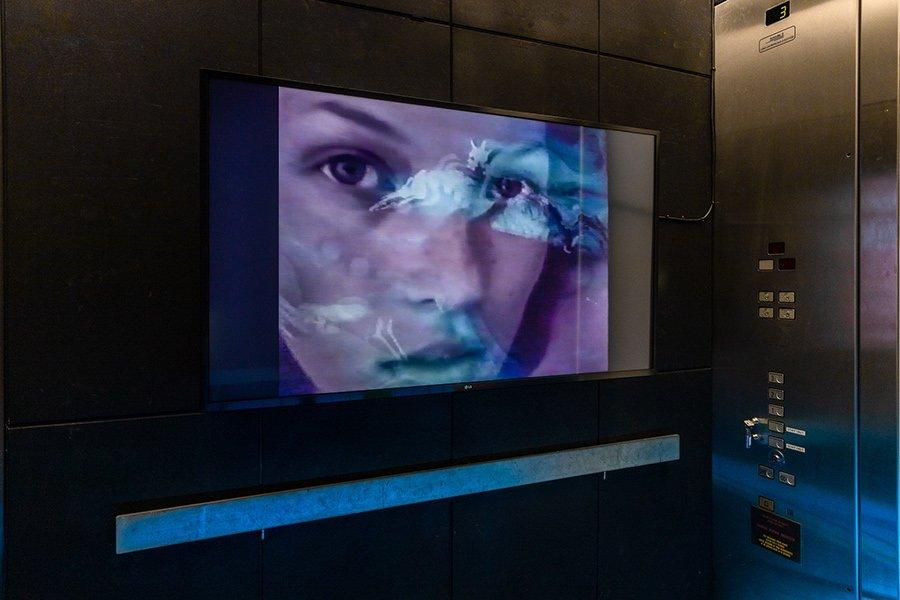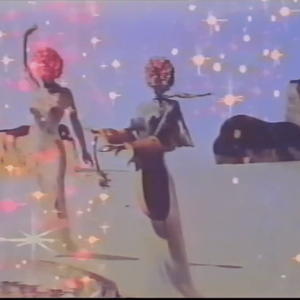In August, I saw the movie Bamboozled (2000) for the first time. This Spike Lee Joint is a satire about a Black TV producer who pitches ‘The New Millennium Minstrel Show’—yes, blackface—to his network in an attempt to make a point.(1) It backfires when the show becomes a hit. Bamboozled, with its fixation on who controls the means of image production, and related themes of mass media appetites and performance under duress, made for a great prelude to the latest exhibition at the Adam Art Gallery, which I saw the following month. Image Processors: Artists in the Medium – A Short History 1968–2020 surveys “a history of moving-image works that focus on mass media.” Curated by Christina Barton, the exhibition showcases many of the gallery’s strengths under her directorship, positioning artists from Aotearoa in relation to an international art history, and giving locals the chance to see artworks both iconic and rarely shown.
Richard Serra’s Television Delivers People (1973) is displayed in the gallery’s front window on a small tube television. Text scrolls by, teleprompter-like, on a blue background. Among the statements that pass: “Television delivers people to an advertiser.” “It is the consumer who is consumed.” “You are the product of t.v.” Fifty years on, we understand quite well that when content is free, it usually means that it’s us being packaged up for advertisers. Billions of us continue to log in, regardless. As an opening salvo in Image Processors, Serra’s work introduces the ideological thread that stitches the exhibition together: mass media regulates society, but artists critique and resist this by co-opting the medium to make their own statements.
In many ways, Image Processors descends conceptually from Theodor Adorno and Max Horkheimer’s influential critique of the “culture industry” (first put forward in 1947). They argued that popular culture functions to subdue, and therefore subjugate, society by cultivating false needs that distract its subjects from enacting the political agency that would serve their true needs. The show’s introductory label quotes American artist and theorist Judith Barry’s statement from 1986 that, “It is only by producing images that the subject of mass culture begins to feel some measure of control over the alienation produced by this condition”. I wonder whether Barry still thinks this today? In our hyperactive image world of user-generated content, you could say that we are now all image producers and broadcasters (or, at least, the tools exist for us to be). And yet, I don’t know that we feel any less alienated. This is to say, I don’t know that the act of producing images feels any more or less inherently political than it did in 1986.
In our hyperactive image world of user-generated content, you could say that we are now all image producers and broadcasters (or, at least, the tools exist for us to be). And yet, I don’t know that we feel any less alienated.
Just inside the gallery is the most recent work, Unchained Malady (2020) by Australian artist Matthew Griffin. The work is made up of 130 layered and compiled clips from news and social media channels, spanning both the end of the Trump Presidency and the Australian Government’s early pandemic response. Initially posted to Instagram, here they’re shown on a towering screen in the middle of the gallery. It has the vibe of a digital billboard, and exudes the familiar contemporary feelings of being steeped in endless media and trying to make sense of pixel soup. Unchained Malady doesn’t hold my attention for long, highlighting the challenge of making art from the very stuff that saturates our daily lives anyway. I agree with Wes Hill’s review of an earlier showing: “Griffin has made a work that, particularly after watching for an hour or so, feels more like an exercise in attending to one’s internet addictions than a Vic Berger-like stab at political parody.”(2) Indeed, the work feels no more potent than Berger’s delirious edits of political clips, posted on YouTube—which is worth noting given the special role the exhibition carves out for artists as critics of mass culture.

Installation view of Unchained Malady (2020) Matthew Griffin. 133 short videos presented on a large screen 54:46 mins, colour/sound, private collection, courtesy the artist and Fine Arts, Sydney. Photo courtesy of the Adam Art Gallery
The fifty-two years represented in Image Processors encompasses many micro-generations of evolving media habits and trends. The show swoops from late-60s news broadcasts, through campy 70s network television, 80s music videos, and the siren call of Y2K advertising. Image Processors also includes the recent rise of algorithmic media in its conception of “mass media,” but I don’t know that the definition holds coherent into this era. It’s the “mass” in “mass media” that troubles it. Through recent elections, referendums, and the pandemic, it’s the fragmentation of the mass into endless individualised feeds governed by algorithm that’s been blamed for the spread of misinformation, individual radicalisation, and growing partisanship.
In this algorithmic present from which none of us can escape, it’s this very fragmentation that makes Arthur Jafa’s Love is the Message, The Message is Death (2016) so powerful. In Jafa’s determination to communicate the horror and beauty in being Black in America, he searches for a collective kind of expression. The work is a montage of historical footage, cameraphone witness, solar flares, and pop-culture clips, all set to Kanye West’s Ultralight Beam. Really, it resists my criticism. My opinion means nothing to the work, even if it means something to me. But I’m glad I got to be immersed in it in a darkened gallery space. The work was made available to stream for forty-eight hours by museums around the world in 2020, as the Black Lives Matter movement began to build. I watched it then, but home viewing is no match for being confronted by it at scale—the projection’s ragged pixels emphasising what Tobi Haslett describes as the essential “poverty” of the image.(3)

Love is the Message, The Message is Death (2016) Arthur Jafa. Digital video projection, 7:25 mins, colour/sound, courtesy of the artist and Gladstone Gallery. Installation view of Image Processors: Artists in the Medium – A Short History 1968–2020, Te Pātaka Toi Adam Art Gallery, Te Herenga Waka—Victoria University of Wellington, 2021. Photo courtesy of the Adam Art Gallery
Unfortunately, not all the works in this exhibition are elevated by their installation in the gallery. Ageing headphones left flakes stuck to our faces and some works needed a bit more heft in their sound. Lisa Reihana’s Wog Features (1990) is projected onto a flat panel on the middle floor of the gallery, an area at the nexus of the building’s many axes. In this location, the work was affected by noise spill from adjacent galleries and its speakers weren’t loud enough to make the work as absorbing as it deserves to be. I do understand the realities of resource limitations; standing in front of Wog Features straining to hear its soundtrack, I felt a little guilty about all the times I myself may have neglected sound quality as a curator.
Wog Features was one of the works I was most looking forward to seeing. Reihana’s video cycles through different performances of racial identities, riffing on popular entertainment—music videos, minstrel shows, and children’s television—implicating audiences and their expectations of the non-White performer along the way. Forged in the pressure cooker of 90s identity politics, it’s still edgy today, not least because of its own critical inclusion of blackface. Similar to other works by Lisa Reihana, such as Hyper Girls (1998), this an artwork with rhythm, driven by the percussion of both its soundtrack and stop-motion elements. This is why the sound is so important. Like the climatic scene in Spike Lee’s Bamboozled (and many of his other films), Wog Features depends on a kind of racially charged madness—the senselessness of racism building to frenzy. Frantic minstrel energy is central to the work. It needs to feel overwhelming, too much to take.

Still from Wog Features (1990) Lisa Reihana. Single channel SD 4:3 video, 7:50 mins, colour/sound, courtesy of the artist. Installation view of Image Processors: Artists in the Medium – A Short History 1968–2020, Te Pātaka Toi Adam Art Gallery, Te Herenga Waka—Victoria University of Wellington, 2021. Photo courtesy of the Adam Art Gallery
Standing in the installation’s black box, you feel like you’re inside television, witnessing the flares and crackles of the broadcast like a lightning storm.
A range of installation strategies are used throughout the show. The location of Megan Dunn’s Obsession (1998) in the gallery’s black and silver elevator plays up its slithering blueness. The gallery’s central staircase is used to great effect in displaying Mike Heynes’s News of the Uruguay Round (2016). I’ve worked with Mike to exhibit this work twice, showing the hand-modelled and animated movie studio logos in gridded arrangements. Here they’re played in sequence, and projected at scale. The staircase forces a slow approach—making them mistakable for actual logo sequences, and only revealing their charming, shonky construction as you descend towards them.
I particularly enjoyed two artworks shown on hissing CRT televisions on the gallery’s bottom floor. The first is New Report Artist Unknown (2005–6) by Wynne Greenwood and K8 Hardy, which takes the form of a spoof news broadcast about some paintings found in a dumpster. A news anchor and a field reporter search for answers, speculating about the artist and why the paintings were discarded—deadpan as they stumble into the metastory of the history and fate of women artists in Western art history. The work’s DIY aesthetic plays well on the tube televisions. It’s delightful to imagine this forced upon audiences as a signal intrusion, hijacking the airwaves. This sixteen-minute work is very funny. My boyfriend and I ended up unplugging the headphone set and listening to the audio through the television’s speaker, so we could watch and giggle along together.
Two televisions along is Martha Rosler Reads Vogue: Wishing, Dreaming, Winning, Spending (1982). It’s just brilliant, even forty years on. It has the sense of a capitalist horror film; its horrors still pervasive in our age of influencers. Rosler, in her red dress, sitting in front of a mirror, feels like she could be a vignette in Peter Strickland’s 2018 Giallo-esque, In Fabric. She delivers her monologue as if she is beholden to the intoxicating force of Vogue magazine’s image world, which slowly becomes unpicked as the work proceeds. “What is Vogue?… It is the hair, the eyes, the skin, the pose of glamour… What is Vogue? It’s the allure of narcissism, it is a threat… “What is Vogue? It is the new face under the old face… Nancy Reagan’s dresses… Have the first lady’s clothes been sewn illegally?…”

Installation view of Image Processors: Artists in the Medium – A Short History 1968–2020, Te Pātaka Toi Adam Art Gallery, Te Herenga Waka—Victoria University of Wellington, 2021. Photo courtesy of the Adam Art Gallery
Spike Lee shot most of Bamboozled on Mini DV camcorder, only switching to cinematic 16mm to show us "The New Millennium Minstrel Show." It’s a choice that asks us to sharpen our perceptions of fabrication versus reality instead of being lulled into passivity by beautiful images.(4) One of this exhibition’s strengths, in tailoring the installation strategy to each work, is its treatment of video artworks as material objects, or, perhaps, material experiences. This encourages us to keep our critical faculties awake, rather than letting our awareness of production dissolve into the smooth, edgeless, high definition of the televisions and personal devices we’ve become accustomed to.
The final work I want to mention is attuned to this—emphasising the medium’s texture over its content. Aldo Tambellini’s Black TV (1968–9) is a two-channel video displayed on abutting flat screens inside a small, specially constructed, matte black room. It samples news broadcasts in split-second bursts of black and white television signal, representing clips captured every day throughout that year. In his book 1968: The Year that Rocked the World, writer Mark Kurlansky argues that television was a catalyst for the sense of global momentum that gathered up disparate struggles and movements around the world that year. In drawing attention to broadcast signal itself, Tambellini highlights the way the imagery of that year’s events streamed into American homes like never before. Standing in the installation’s black box, you feel like you’re inside television, witnessing the flares and crackles of the broadcast like a lightning storm.

Installation view of Black TV (1968–69) Aldo Tambellini. 16mm film transferred to 4K single channel digital video, 10 mins, black and white/sound, courtesy of the artist’s estate and Light Cone, Paris. Installation view of Image Processors: Artists in the Medium – A Short History 1968–2020, Te Pātaka Toi Adam Art Gallery, Te Herenga Waka—Victoria University of Wellington, 2021. Photo courtesy of the Adam Art Gallery
Ultimately, this exhibition made me think about the different spaces where critique occurs in contemporary culture, and the erratic potency of each. The threat of mass media lies in the scale of its audience, but this is also its potential. Effective critique does emerge on YouTube, TikTok, and at the movies. So how does this alter the role of the gallery, if it is not a privileged site for such commentary? What do we seek from our gallery experiences when artworks or art-like experiences might also be seen in the more mundane and ever-proliferating image worlds that we occupy? Material experiences, yes, and a space that resists algorithmic logic. While our feeds continually refresh, pushing older content into oblivion, the gallery instead makes space for works to converse across time. Like a movie theatre, the gallery carves out both space and duration, asking something of our attention spans. And most importantly, the gallery is a space that favours the logic of connections over the arbitrary sequences of disparate content to which we’ve become so accustomed.


